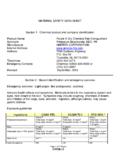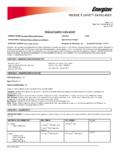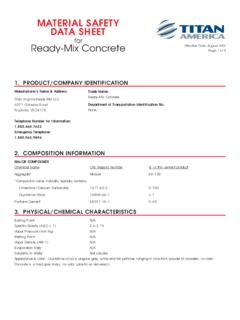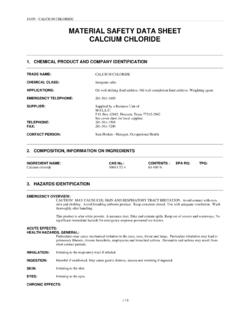Transcription of VULTAC ® TB7 - Altamax
1 Material Safety Data Sheet VULTAC TB7. 1. PRODUCT AND COMPANY IDENTIFICATION. Company Arkema Inc. 900 First Avenue King of Prussia, Pennsylvania 19406. Thio and Fine Chemicals Customer Service Telephone Number: (800) 628-4453. (Monday through Friday, 8:30 AM to 5:30 PM EST). Emergency Information Transportation: CHEMTREC: (800) 424-9300. (24 hrs., 7 days a week). Medical: Rocky Mountain Poison Center: (866) 767-5089. (24 hrs., 7 days a week). Product Information Product name: VULTAC TB7. Synonyms: Para-tertiobutylphenol Disulfide Polymer Molecular formula: Not available Chemical family: Polysulfide Product use: Vulcanization agent 2. HAZARDS IDENTIFICATION. Emergency Overview Color: dark amber Physical state: solid Form: Beads Odor: slightly, acidic WARNING! MAY CAUSE ALLERGIC SKIN REACTION. Potential Health Effects Primary routes of exposure: Inhalation and skin contact.
2 Signs and symptoms of acute exposure: Prolonged or repeated exposure may cause: Allergic skin reaction: redness, rash. Skin: Practically non-irritating. May cause allergic skin reaction. (based on animal studies). Eyes: Slightly irritating. (based on animal studies). Ingestion: Product code: 000291 Version Issued on: 07/11/2011 Page: 1 / 8. Material Safety Data Sheet VULTAC TB7. No more than slightly toxic. (based on animal studies). 3. COMPOSITION/INFORMATION ON INGREDIENTS. Chemical Name CAS-No. Wt/Wt OSHA. Hazardous Phenol, 4-(1,1-dimethylethyl)-, polymer with sulfur 60303-68-6 > 95 % Y. chloride (S2Cl2). Sulfur 7704-34-9 <3% Y. The substance(s) marked with a "Y" in the Hazard column above, are those identified as hazardous chemicals under the criteria of the OSHA Hazard Communication Standard (29 CFR ). This material is classified as hazardous under Federal OSHA regulation.
3 4. FIRST AID MEASURES. Inhalation: If inhaled, remove victim to fresh air. Skin: In case of contact, immediately flush skin with soap and plenty of water. Remove contaminated clothing and shoes. Get medical attention if symptoms occur. Eyes: Immediately flush eye(s) with plenty of water. Ingestion: If swallowed, DO NOT induce vomiting. Get medical attention. Never give anything by mouth to an unconscious person. 5. FIRE-FIGHTING MEASURES. Flash point > 482 F (> 250 C) (Tag closed cup). Auto-ignition temperature: not determined Lower flammable limit (LFL): Not determined Upper flammable limit (UFL): Not determined Extinguishing media (suitable): water spray, Carbon dioxide (CO2), Foam, Dry chemical Protective equipment: Fire fighters and others who may be exposed to products of combustion should wear full fire fighting turn out gear (full Bunker Gear) and self-contained breathing apparatus (pressure demand / NIOSH approved or equivalent).
4 Further firefighting advice: Fire fighting equipment should be thoroughly decontaminated after use. Product code: 000291 Version Issued on: 07/11/2011 Page: 2 / 8. Material Safety Data Sheet VULTAC TB7. Fire and explosion hazards: When burned, the following hazardous products of combustion can occur: Carbon monoxide sulfur oxides carbon dioxide 6. ACCIDENTAL RELEASE MEASURES. In case of spill or leak: Spills should be contained and placed in suitable containers for disposal. Sweep up and shovel into suitable containers for disposal. Consult a regulatory specialist to determine appropriate state or local reporting requirements, for assistance in waste characterization and/or hazardous waste disposal and other requirements listed in pertinent environmental permits. 7. HANDLING AND STORAGE. Handling General information on handling: Avoid prolonged or repeated contact with skin.
5 Wash thoroughly after handling. Emptied container retains vapor and product residue. Observe all labeled safeguards until container is cleaned, reconditioned or destroyed. Storage General information on storage conditions: Stable under normal conditions. Storage incompatibility General: Store separate from: Strong oxidizing agents 8. EXPOSURE CONTROLS/PERSONAL PROTECTION. Airborne Exposure Guidelines: Particles Not Otherwise Specified / Nuisance Dust US. ACGIH Threshold Limit Values Form: Inhalable particles. Time Weighted Average (TWA): 10 mg/m3. Form: Respirable particles. Time Weighted Average (TWA): 3 mg/m3. US. OSHA Table Z-1 Limits for Air Contaminants (29 CFR ). Form: Respirable fraction. PEL: 5 mg/m3. Product code: 000291 Version Issued on: 07/11/2011 Page: 3 / 8. Material Safety Data Sheet VULTAC TB7. Remarks: All inert or nuisance dusts, whether mineral, inorganic, or organic, not listed specifically by substance name are covered by the Particulates Not Otherwise Regulated (PNOR) limit which is the same as the inert or nuisance dust limit of Table Z-3.
6 Form: Total dust. PEL: 15 mg/m3. Remarks: All inert or nuisance dusts, whether mineral, inorganic, or organic, not listed specifically by substance name are covered by the Particulates Not Otherwise Regulated (PNOR) limit which is the same as the inert or nuisance dust limit of Table Z-3. Only those components with exposure limits are printed in this section. Limits with skin contact designation above have skin contact effect. Air sampling alone is insufficient to accurately quantitate exposure. Measures to prevent significant cutaneous absorption may be required. Limits with a sensitizer designation above mean that exposure to this material may cause allergic reactions. Engineering controls: Investigate engineering techniques to reduce exposures below airborne exposure limits or to otherwise reduce exposures. Provide ventilation if necessary to minimize exposures or to control exposure levels to below airborne exposure limits (if applicable see above).
7 Provide ventilation if necessary to control exposure levels below airborne exposure limits (see above).If practical, use local mechanical exhaust ventilation at sources of air contamination such as open process equipment. Respiratory protection: Where airborne exposure is likely or airborne exposure limits are exceeded (if applicable, see above), use NIOSH approved respiratory protection equipment appropriate to the material and/or its components (full facepiece recommended). Consult respirator manufacturer to determine appropriate type equipment for a given application. Observe respirator use limitations specified by NIOSH or the manufacturer. For emergency and other conditions where there may be a potential for significant exposure or where exposure limit may be significantly exceeded, use an approved full face positive-pressure, self-contained breathing apparatus or positive-pressure airline with auxiliary self-contained air supply.
8 Respiratory protection programs must comply with 29 CFR Skin protection: Wear appropriate chemical resistant protective clothing and chemical resistant gloves to prevent skin contact. Consult glove manufacturer to determine appropriate type glove material for given application. Rinse immediately if skin is contaminated. Wash contaminated clothing and clean protective equipment before reuse. Wash thoroughly after handling. Eye protection: Use good industrial practice to avoid eye contact. Product code: 000291 Version Issued on: 07/11/2011 Page: 4 / 8. Material Safety Data Sheet VULTAC TB7. 9. PHYSICAL AND CHEMICAL PROPERTIES. Color: dark amber Physical state: solid Form: Beads Odor: slightly, acidic pH: not determined Density: 1,175 kg/m3 (176 F (80 C)). Bulk density: 805 kg/m3 68 F (20 C). Vapor pressure: not applicable Vapor density: not applicable Softening point: 221 F (105 C).
9 Solubility in water: < 1 mg/l 77 F (25 C) insoluble Solubility in other Toluene > 600 g/l solvents: [qualitative and 77 F (25 C). quantative]. Ethanol 15 - 20 g/l 77 F (25 C). Acetone 30 - 40 g/l 77 F (25 C). Viscosity, dynamic: 1,100 302 F (150 C). Thermal decomposition 423 F (217 C). 10. STABILITY AND REACTIVITY. Stability: This material is chemically stable under normal and anticipated storage, handling and processing conditions. Materials to avoid: Strong oxidizing agents Conditions / hazards to avoid: Avoid dust formation. Hazardous decomposition products: No decomposition if stored normally. Product code: 000291 Version Issued on: 07/11/2011 Page: 5 / 8. Material Safety Data Sheet VULTAC TB7. 11. TOXICOLOGICAL INFORMATION. Data on this material and/or its components are summarized below. Data for VULTAC TB7. Acute toxicity Oral: No more than slightly toxic.
10 (rat) LD0 = 2,000 mg/kg. Skin Irritation: Practically non-irritating. (rabbit) (4 h). Eye Irritation: Slightly irritating. (rabbit) Skin Sensitization: Repeated skin exposure. (guinea pig) Skin allergy was observed. Genotoxicity Assessment in Vitro: No genetic changes were observed in laboratory tests using: bacteria, animal cells 12. ECOLOGICAL INFORMATION. Chemical Fate and Pathway No data are available. Ecotoxicology No data are available. 13. DISPOSAL CONSIDERATIONS. Waste disposal: Disposal via incineration is recommended. Dispose of in accordance with federal, state and local regulations. Consult a regulatory specialist to determine appropriate state or local reporting requirements, for assistance in waste characterization and/or hazardous waste disposal and other requirements listed in pertinent environmental permits. Note: Chemical additions to, processing of, or otherwise altering this material may make this waste management information incomplete, inaccurate, or otherwise inappropriate.







